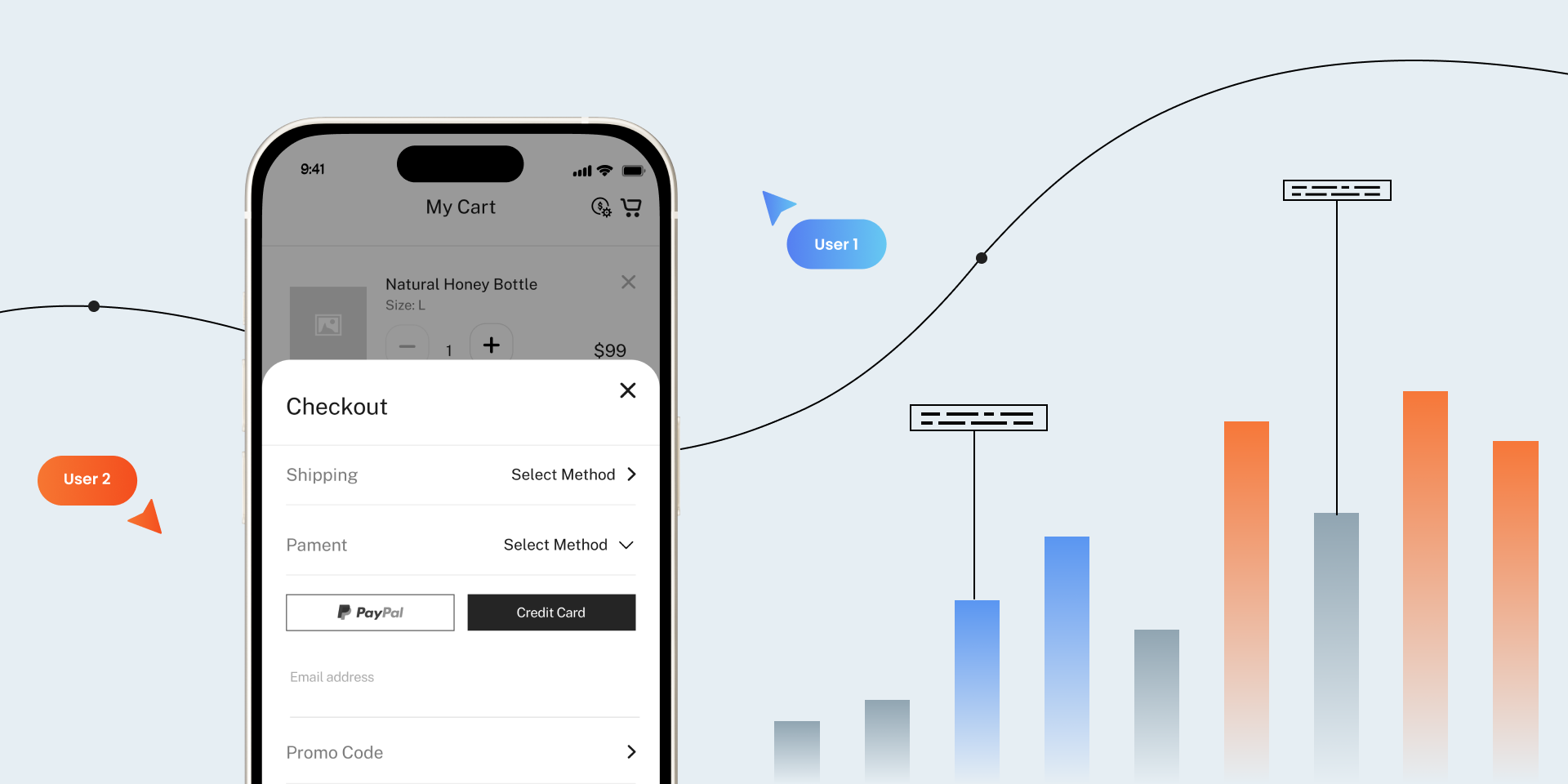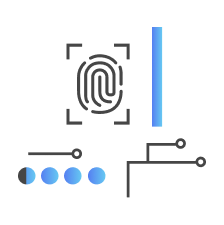Every day, your mobile app competes for survival.
Users won’t hesitate to delete apps that crash, lag, or drain their battery. A few serious bugs can erase months of development work.
That’s why we have been successfully selling mobile QA since the dawn of time. It just gets more necessary every year, and we know how to test for crashes, handle countless device types, and cut your support costs.
Here, we will walk you through the frameworks, the costs, and the exact steps to get your mobile app testing right — from pre-launch to post-release, from manual QA to AI test automation.
Why you should care:
- Your app is part of a $14 trillion global mobile market.
- One big crash can make 71% of users uninstall.
- Rapid release cycles mean you can’t afford slow or sloppy QA.
- The right testing strategy cuts support costs and boosts ROI.
Whether you’re launching a new app or improving an existing one, you’ll learn how to make testing a strategic advantage, not just a checkbox.
Let’s do it.
Key Takeaways
- Mobile app quality is critical: one crash can cause 71% of users to uninstall your app permanently.
- A strategic mix of manual testing, traditional automation, and AI-powered automation delivers the best coverage and efficiency.
- Manual testing excels in user experience, exploratory scenarios, and early-stage projects, while automation speeds up regression and repetitive testing.
- AI testing adapts dynamically to changes, reduces maintenance, and uncovers edge cases for complex apps.
- Mobile app testing must cover device-level, application-level, performance, security, and compliance requirements across native, web, and hybrid apps.
- Effective mobile testing strategies depend on the app type (enterprise, consumer, B2B) and should tailor the balance of manual, automated, and AI testing accordingly.
- Test early and continuously: shift-left testing and integration of testing in development help prevent costly fixes later.
- Use cloud device farms and real devices to overcome fragmentation challenges and ensure compatibility across OS versions and custom Android UIs.
- Continuous monitoring after release (crash analytics, user behavior tracking) is essential to maintain app quality and compliance.
- Focus on key performance metrics like launch time, memory usage, crash rate, and frame rate for ongoing quality assurance.
Strategic Role of Mobile App Testing
We have spared an unusual amount of article space to prove that mobile app QA should not be an afterthought. It is a strategic advantage, a necessary insurance, and a way to save money where others burn budgets.
Sink in this strategic overview, get the “Why,” and then the “How” will be just a technical issue, not much of a challenge.
#1. Market context
The mobile app ecosystem has reached a critical inflection point in 2025. With over 7.5 billion mobile users worldwide, the stakes for quality assurance have never been higher. Key market indicators show:
- Daily app usage averages 4.2 hours per user.
- 65% of digital commerce now happens through mobile apps.
- Enterprise apps have seen a 120% growth in adoption since 2023.
- Mobile wallet transactions are projected to exceed $14 trillion globally.
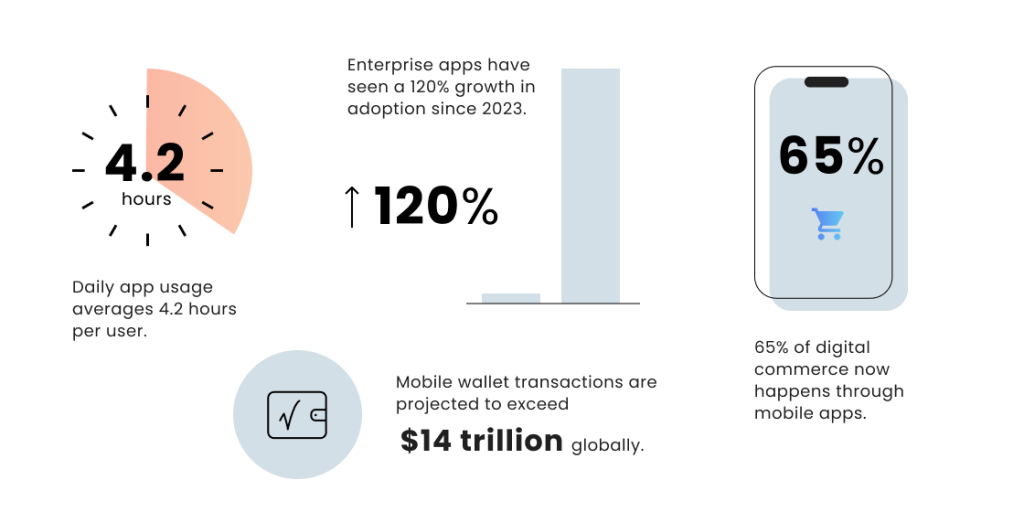
Industry trends demand:
Rapid release cycles
- Average app update frequency: Every 2-3 weeks.
- Critical bug fix deployment: Expected within 24 hours.
- Feature deployment expectations: Weekly for consumer apps.
Cross-platform complexity
- 85% of businesses require both iOS mobile application testing and Android application testing.
- Average enterprise app supports 4+ OS versions simultaneously.
- Mobile app manual testing coverage must span 40+ popular device types.
User experience demands
- 92% of users judge apps by their first-use experience.
- 3-second loading time maximum tolerance.
- Zero-crash tolerance from enterprise users.
#2. Cost of quality issues
Before you read any further, let’s do some math. There is nothing more motivational than improving your app quality assurance system. No theories can beat real potential loss numbers you see with your own eye.
Once we are done here, let’s move to mobile software testing at its best — customized test plans, APIs that actually work, and testing tools worthy of the “ever-changing” 2025 market, as Chat GPT would put it.
User retention impact
Documented by app analytics platforms like AppsFlyer and Mixpanel:

App store performance
Verifiable through App Store and Google Play metrics:
- Apps with crashes affecting >1% of sessions see average rating drop of 1-2 stars
- Each star rating drop correlates to an approximately 15% decrease in downloads
- Apps with consistent crashes see 30-40% higher uninstall rates
Development time impact
Measurable through project management tools:
Bug Fix Cost = (Developer Hourly Rate × Average Fix Time) + (QA Hourly Rate × Verification Time)
Example:
Developer Rate: $75/hour;
Average Fix Time: 4 hours;
QA Rate: $50/hour;
Verification Time: 2 hours.
Total Cost Per Bug = ($75 × 4) + ($50 × 2) = $400
Support Cost Calculation
Trackable through support ticket systems:
Monthly Support Cost = (Tickets Per Month × Average Resolution Time × Support Staff Rate)
Example of a bug-related issue:
100 tickets/month
30 minutes average resolution
$30/hour support staff rate
Monthly Impact = 100 × 0.5 hours × $30 = $1,500
Revenue Impact Analysis
For e-commerce apps, measurable through analytics:
Revenue Loss = (Average Hourly Transactions × Average Transaction Value × Error Rate)
Example:
1,000 transactions/hour
$50 average transaction
5% error rate during issue
Hourly Revenue Impact = 1,000 × $50 × 0.05 = $2,500
#4. Prevention cost analysis
There’s a simple truth in mobile app development that every technical leader discovers sooner or later: preventing issues is a lot cheaper than fixing them. And yes, we can actually measure this.
Think of it as insurance. You wouldn’t drive a car without it, so why launch an app without proper testing? The math here is surprisingly straightforward, and it might just help you win your next budget discussion with the finance team.
Calculate ROI of preventive testing:
Testing ROI = (Cost of Issues Prevented – Cost of Testing) / Cost of Testing
Components
| Testing costs | Prevention value |
| QA team hoursTesting infrastructureTool licensesDevice lab maintenance | Reduced support ticketsMaintained app store ratingPreserved user baseAvoided emergency fixes |
#5. Regulatory compliance
In 2025, we’re seeing regulators take an increasingly active role in mobile app oversight. Miss these requirements, and you’re not just risking bugs – you’re risking your entire business model.
Compliance is your app’s immune system. You might not see it working, but you’ll definitely notice when it fails. Here’s what you need to watch out for:
Data privacy requirements
First things first – if you’re collecting user data (and let’s face it, most apps do), you need to handle it properly. This means:
- GDPR compliance if you have European users (fines up to €20M or 4% of global revenue)
- CCPA requirements for California users
- Local data protection laws in over 120 countries
- Proper user consent management
- Clear data deletion processes
The trick here isn’t just implementing these requirements – it’s testing them regularly to ensure they actually work. One failed audit can cost more than a year’s worth of testing.
Industry-specific rules
Different industries have their own sets of rules. Here’s what you need to know:
| For fintech apps | For healthcare apps | For E-commerce |
| – PSD2 compliance for payment processing -Two-factor authentication requirements -Transaction monitoring -Regular security audits | – HIPAA compliance – Patient data encryption – Access control testing – Audit trail maintenance | – Payment processing standards – Return policy compliance – Product information accuracy – Price display requirements |
Security testing requirements
This is where mobile testing gets serious. Every app needs:
- End-to-end encryption testing
- Penetration testing
- API security verification
- Session management checks
- Data storage security validation
The good news? Most of these tests can be automated. The bad news? You need to run them consistently and document everything.
Need help building your mobile testing strategy?
Schedule a free consultation with our QA architects.
Types of Mobile Apps: QA Focus Areas
There are three main types of mobile apps, each requiring different testing methods. Here they are:
- Native apps – these apps are designed for specific platforms and operating systems.
- Mobile web apps – also known as progressive web apps, can work on any mobile device while being accessible through mobile browsers.
- Hybrid apps (or Cross-browser apps) – these apps combine the functionality of both native and mobile web apps. They are created using a mixture of technologies like CSS, HTML5, PHP, and Java and take less time to deploy compared to native apps.
Native Apps
When companies opt for native app development, they make a clear choice: maximum performance and user experience over development speed and cost. Here is why native apps are so popular:
Platform optimization
Native apps speak directly to the operating system, creating a straightforward line to your device’s hardware. Your app can instantly access cameras, GPS, and sensors without any middlemen.
Every animation and transition flows naturally because no translation layer slows things down. Memory management happens at the hardware level, meaning complex operations work faster.
User experience excellence
Native apps feel like they belong on your device — because they do. When users swipe, tap, or pinch, the app responds exactly as they expect it to. The interface matches what they see in their other apps, making everything feel familiar and intuitive. When a user taps a button, there’s no delay — the app responds instantly.
Need to use the camera or share a file? It just works because the app is deeply integrated with all the device features users rely on.
Performance advantages
The direct hardware access of native apps makes everything run smoother and faster. Apps start up almost instantly because they’re optimized for your specific device. Battery life is better because the app knows exactly how to manage power efficiently.
Users can switch between tasks seamlessly, and when they’re playing games or watching videos, the graphics are crisp and responsive.
Critical testing requirements for Native Apps
Testing native apps requires a comprehensive approach that balances platform-specific requirements with overall quality assurance.
| Platform-Specific Testing Priorities | |
| iOS | Android |
| – Human Interface – Guidelines compliance – Performance across different models – iCloud integration testing – Apple privacy framework verification – App Store submission requirements | – Material Design compliance – Device fragmentation testing – Background process optimization – Permission handling verification – Google Play Store requirements |
| Device Feature Integration | Performance QA Focus Areas | Compliance and Submission |
| – Camera functionality – Location services – Biometric authentication – Push notifications – Background processes – Storage access – Sensor utilization | – Launch time (< 2 sc.) – Memory usage – Battery consumption – Network efficiency – Background behavior – State preservation/restoration | – Security standards – Privacy guidelines – Performance benchmarks – UI/UX requirements – Content policies |
Real-world applications
Different types of native apps require specific testing approaches:
| Banking Apps | Photo/Video Editors | High-Performance Games | Fitness Trackers |
| Security features Transaction processing Biometric authentication Offline capabilities Data encryption | Processing performance Memory management Storage handling Export/import functionality Filter/effect accuracy | Frame rate stability Graphics rendering Audio synchronization Input responsiveness Memory leaks | Sensor accuracy Background tracking Data synchronization Battery optimization Health kit integration |
Mobile app testing strategy recommendations
For effective native mobile app QA testing, we recommend:
| Device coverage | Automation balance |
| – Test on real devices, not just emulators – Cover most popular device models – Include older devices and OS versions – Test on different screen sizes | – Automate repetitive tests – Manual testing for user experience – Hybrid approach for feature testing – Regular regression testing |
| Performance monitoring | Quality assurance process |
| – Implement crash reporting – Track key performance metrics – Monitor user behavior – Analyze performance patterns | – Regular testing cycles – Continuous integration – Automated smoke tests – Pre-submission checklists |
While native app development costs more upfront, proper testing ensures you get the maximum return on this investment through better user satisfaction and fewer post-release issues.
Web app QA: Cross browser testing and beyond
Progressive web apps and mobile web applications continue to be popular. They offer a cost-effective way to reach mobile users without the complexities of native development. Here’s what makes web apps different and how to test them effectively.
Modern web apps offer a balanced approach to mobile presence:
- 30-40% lower development costs;
- Single codebase maintenance;
- No app store approval needed;
- Instant updates and access;
- Universal device compatibility;
Core testing requirements
Browser priority matrix
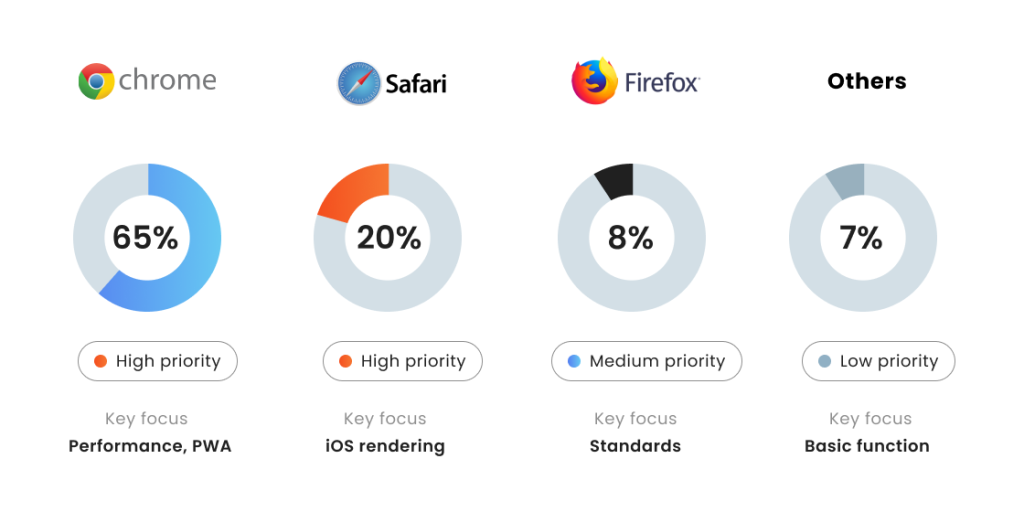
Performance benchmarks
– Initial load: < 3 seconds
– Time to interact: < 5 seconds
– Offline functionality
– Smooth scrolling (60fps)
– Responsive breakpoints
Essential testing tools
BrowserStack/LambdaTest
- Real device testing
- Screenshot comparison
- Responsive design validation
Performance tools
- Lighthouse for audits
- WebPageTest for speed
- GTmetrix for optimization
Web-specific test areas
| PWA requirements | Mobile Web Features |
| Offline functionality Installation experience Push notifications Background sync | Touch gestures Device orientation Form handling Media capture Keyboard interaction |
Common issues and solutions
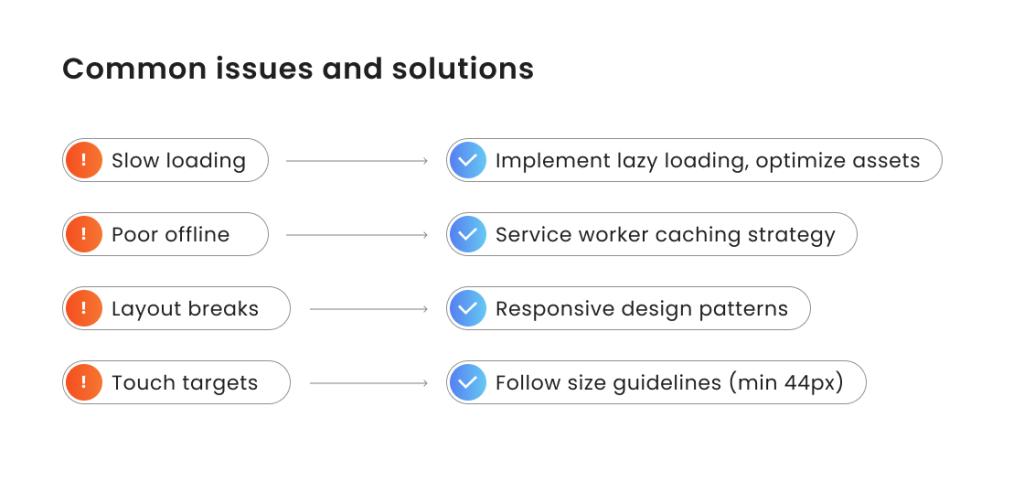
Cross-platform apps (Hybrid): Test smarter, deploy faster
When every market day counts, and budgets aren’t unlimited, cross-platform development becomes an attractive option. These apps run on both iOS and Android from a single codebase, which changes everything about how we approach mobile app testing and development.
Development savings
- 40% less development time compared to native
- Single QA team instead of platform-specific teams
- Unified bug tracking and resolution
- Faster feature rollout
Testing costs to consider
- Testing Infrastructure = Base tools + Device lab + Cloud testing Team
- Costs = QA Engineers + Platform Specialists
- Maintenance = Framework updates + Platform updates
Framework testing comparison
| Framework | Testing tools | Key testing areas | Common issues |
| React Native | Jest, Detox | Component rendering, Native bridges | Navigation bugs, Memory leaks |
| Flutter | Flutter Test, Integration Tests | Widget testing, State management | Platform inconsistencies, Performance on older devices |
| Xamarin | NUnit, UITest | Platform APIs, UI automation | Resource management, Native feature gaps |
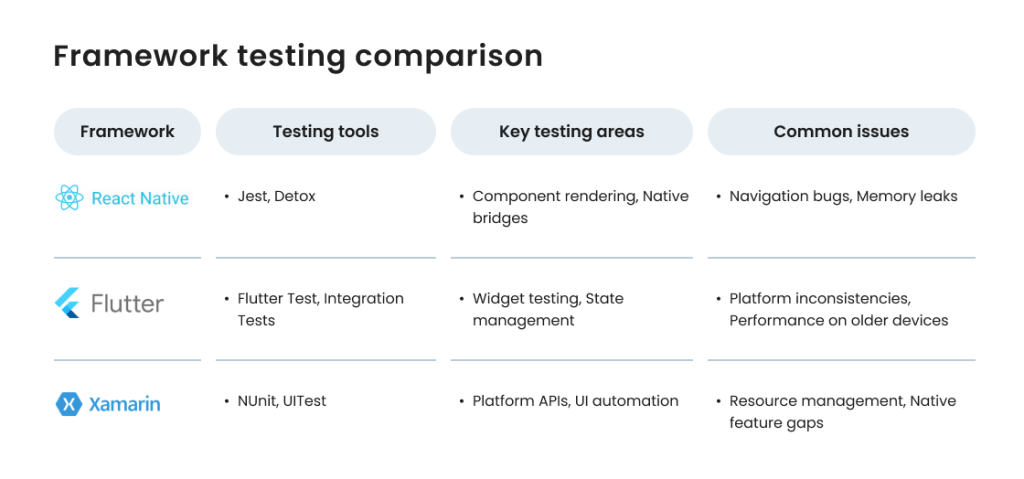
Key metrics to track
| Metric | Acceptable range | Warning signs |
| App launch time | < 2 seconds | > 3 seconds |
| Memory usage | < 150MB active | Steady increase over time |
| Frame rate | 60 fps | Drops below 30 fps |
| API response | < 1 second | > 2 seconds or timeouts |
| Crash rate | < 0.1% | > 1% of sessions |
Do Frequent Releases Confidently while We Handle QA
We help you speed up mobile app releases and ensure that no serious defects leak into production.
What Mobile Application Testing Includes
Testing mobile apps requires a comprehensive strategy that’s quite different from web testing. Let’s break down what makes mobile testing unique and how to ensure your app meets user expectations.
#1. Device-level testing
The modern mobile testing process starts with the hardware. Whether you test a mobile app on Android or iOS, you need to verify:
| Component | What to Test | Why It Matters |
| Hardware Integration | Sensors, Camera, GPS | Core functionality |
| Resource Management | Memory, Storage, Battery | App performance |
| Connectivity | WiFi, Bluetooth, Cellular | User experience |
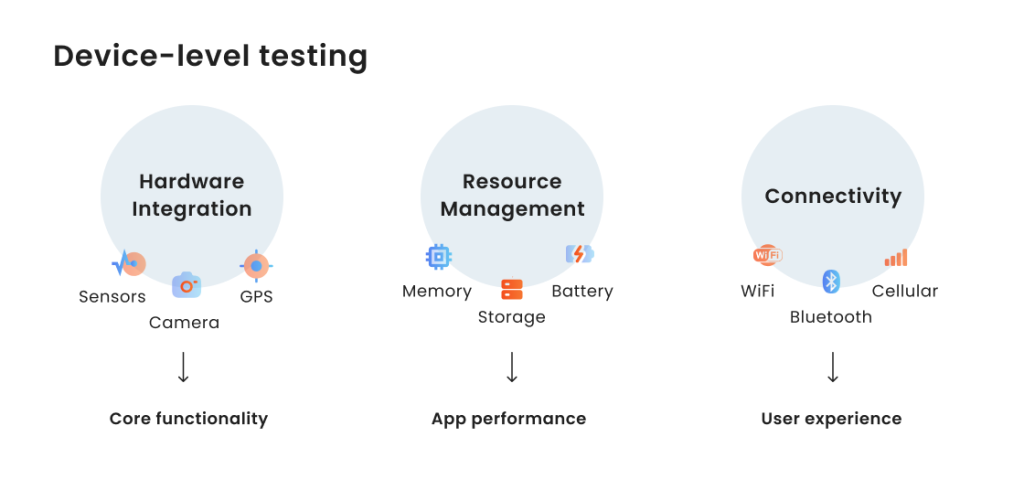
#2. Application-level testing
Mobile application QA involves both automated and manual approaches:
Technical testing
- White Box: Direct code testing by developers
- Black Box: End-user perspective testing
- Gray Box: Combined approach for balanced coverage
Functional areas
| Core functionality | User experience |
| Feature validation Data handling Error management Update processes | Navigation flows Input methods Response times Visual consistency |
#3. Essential types of testing
| Performance testing | Compatibility testing |
| Load handling Response time Resource usage Battery impact | Device types OS versions Screen sizes Network conditions |
| Security testing | Usability testing |
| Encryption verification Permission handling Data storage security Network security | Navigation ease Interface clarity Error handling Accessibility |
| Interrupt testing | Functional testing |
| Phone calls Messages Notifications Battery alerts | Core features Data validation Business logic User workflows Error scenarios Integration points Edge cases State management |
Ready to get started?
Let’s test your mobile app better. Faster. With your users in mind.
Mobile Test Automation and Manual QA
Testing isn’t glamorous but is the backbone of any successful mobile app. Without it, even the best ideas can fail spectacularly. And while automation has made considerable strides in recent years — especially with AI stepping in — manual testing still holds its ground where human insight is irreplaceable.
Not every test should be automated, and not every project can rely solely on manual effort.
Here is our take on when to lean on speed and precision and when to bring in adaptability and intuition.
Here’s a brief breakdown of manual testing, traditional automation, and AI
Automated testing
Automated testing involves creating scripts that perform predefined tests without manual intervention. These scripts target specific outcomes, and QA engineers analyze results to ensure the application meets quality standards. This approach allows mobile QA teams to efficiently handle repetitive tasks and allocate resources to more complex issues.
Advantages of automated testing
- Speed. Automated testing executes tasks significantly faster than manual testing, making it ideal for regression testing and repetitive scenarios.
- Reusability. Test scripts can be reused across various development phases and devices, ensuring consistency and reducing redundant efforts.
- Precision. Automation eliminates human error, delivering more accurate and reliable results in a shorter timeframe.
Challenges of automated testing
- Initial setup. Developing and configuring automated test scripts requires significant time, technical expertise, and investment.
- Maintenance. As the application evolves, test scripts must be updated regularly to reflect changes in the codebase. It can strain teams with limited resources.
- Scope limitations. Automated testing may not effectively handle exploratory or intuitive testing scenarios requiring human judgment.
AI-powered automation
In 2025, AI has become a critical component of test automation. Unlike traditional automation, which relies on predefined scripts, AI-driven tools learn from application behavior and adapt dynamically, making them especially powerful for complex and evolving projects.
Advantages of AI automation
- Self-learning capabilities. AI tools analyze user behavior and application changes, generating smarter test cases and reducing human input.
- Dynamic testing. AI detects and adapts to minor UI or code changes, minimizing script maintenance.
- Enhanced coverage. Machine learning algorithms identify edge cases and optimize test scenarios to ensure comprehensive testing.
- Cost efficiency. By automating advanced scenarios, AI reduces long-term costs and accelerates release cycles.
Challenges of AI automation
- Initial investment. AI automation tools often come with higher upfront costs compared to traditional tools.
- Skill requirements. Implementing AI-powered automation requires a strong understanding of both AI tools and testing frameworks.
- Data dependency. AI tools rely heavily on quality data to produce reliable results. Poor training data can lead to flawed testing outcomes.
Manual testing
Despite advances in automation, manual testing remains indispensable for specific scenarios. It involves QA analysts executing test cases by hand to evaluate an app’s functionality, usability, and overall user experience. Manual testing is particularly vital for scenarios that require human intuition or empathy.
Advantages of manual testing
- Adaptability. Testers can quickly adjust their approach based on observed behavior, making manual testing essential for exploratory and usability testing.
- Human insight. Manual testing excels in areas like user experience, where human intuition identifies issues that automation tools may overlook.
- Low Initial investment. For small-scale projects or startups, manual testing is often the most feasible option.
Challenges of manual testing
- Time-consuming. Repetitive tasks take significantly longer compared to automated testing.
- Limited scalability. As projects grow, manual testing may struggle to cover all scenarios effectively.
- Prone to errors. Human involvement introduces the potential for mistakes, particularly in repetitive or highly technical testing scenarios.
A one-size-fits-all testing strategy doesn’t exist. The choice between manual, traditional automated, and AI-powered testing depends on the project’s requirements, complexity, and scale.
- For large-scale projects
- Use AI automation for dynamic scenarios and edge case coverage.
- Leverage traditional automation for regression testing and repetitive tasks.
- Rely on manual testing for exploratory testing and user experience validation.
- For small-scale projects:
- Manual testing is cost-effective and adaptable when the project scope is limited.
- Basic automation can be introduced if scalability becomes a priority.
- When automation falls short:
- UI interactions, device compatibility, and real-world user behavior are best handled through manual testing or supplemented with AI testing tools.
We will simplify it even more, but please don’t take it as a directive. Every project is unique; these are just common correlations.
Simplified cost-benefit analysis: AI, manual and automated testing
| Approach | Initial Cost | Monthly Cost | Time to ROI |
| Traditional Automation | High | Medium | 6-8 months |
| AI Testing | Very High | Low | 3-4 months |
| Manual Testing | Low | High | Immediate |
Custom Mix to Test Mobile Applications Smartly
Different apps have unique challenges, serve diverse audiences, and require specialized testing methods to ensure they perform seamlessly across multiple devices and platforms.
To test a mobile app effectively, you need the right mix of manual testing, mobile test automation, and AI-powered testing. Each method plays a vital role in end-to-end testing, helping you identify performance issues, ensure compliance, and validate real-world user experiences. Let’s break down how tailored testing strategies can make your app store-ready and highly competitive.
Enterprise apps
This combination is best for:
- Financial systems
- Healthcare platforms
- Enterprise resource planning
- Government applications
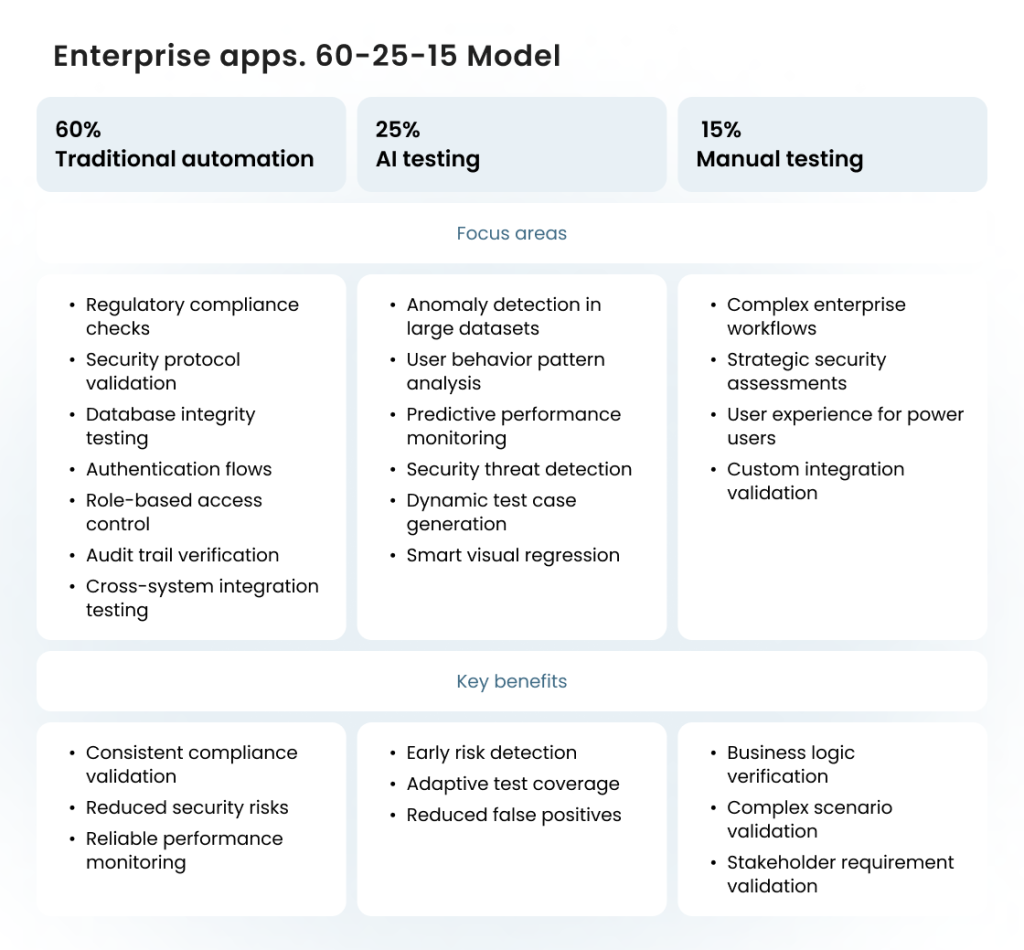
Consumer apps
This mobile application QA testing split is best suited for:
- Social media apps
- E-commerce platforms
- Entertainment apps
- Gaming applications
| Consumer apps | ||
| 40-30-30 Model | ||
| 40% Traditional automation | 30% AI testing | 30% Manual testing |
| Focus areas | Focus areas | Focus areas |
| Core feature regression Payment processing Basic navigation flows Cross-device compatibility Performance benchmarks Social media integration | User journey optimization Content recommendation testing Personalization validation Visual consistency Load pattern analysis Smart UI testing | User experience evaluation Content quality assessment Emotional response testing Accessibility validation Cultural adaptation testing |
| Key benefits | Key benefits | Key benefits |
| Fast release cycles Consistent basic functionality Reliable core features | Better user experience coverage Improved personalization testing Faster visual validation | Real user perspective Cultural nuance validation Subjective quality assessment |
B2B/SaaS Apps
This mobile QA testing mix may be optimal for:
- CRM systems
- Project management tools
- Collaboration platforms
- Business analytics tools
| B2B/SaaS Apps | ||
| 50-30-20 Model | ||
| 50% Traditional automation | 30% AI testing | 20% Manual testing |
| Focus areas | Focus areas | Focus areas |
| API testing Integration testing Data validation Performance monitoring Subscription flow testing Multi-tenant testing Configuration testing | Smart regression testing Pattern analysis Anomaly detection Usage pattern optimization Service health prediction Resource scaling validation | Complex business workflows Enterprise compliance checks Integration validation Client-specific customizations Partner integration testing |
| Key benefits | Key benefits | Key benefits |
| Reliable service delivery Consistent integration validation Stable platform operation | Proactive issue detection Optimized resource usage Improved service reliability | Business logic accuracy Customer-specific validation Complex workflow verification |
Quality Engineering in Action!
Learn how we handled QA for a Gulf region mobile investment app. Localized filter features, strict compliance and security requirements.
A smart, customized mobile application QA testing approach isn’t just a technical necessity—it’s a business advantage. By identifying the right types of testing for your app, you can:
- Ensure that the app meets performance, security, and usability standards.
- Minimize risks like app crashes, poor user experience, and missed compliance requirements.
- Optimize mobile testing tools to reduce costs and accelerate beta testing and release cycles.
Each category of apps — enterprise, consumer, or B2B — benefits from a thoughtful testing mix. Whether it’s validating native and hybrid mobile apps, conducting device testing across multiple mobile platforms, or leveraging AI for smarter automation, testing helps you deliver an app that users trust and love.
When it comes to testing mobile applications, the right balance of techniques ensures your app performs consistently, adapts to evolving user needs, and thrives in today’s competitive digital landscape.
Tools and Techniques for Mobile Testing
The right tools make the difference between efficient testing and endless debugging. Here’s our tested toolkit for modern mobile QA:
Test management platforms
| Tool | Best For | Key Features | Price Range |
| TestRail | Enterprise | Test case management, Metrics tracking | $30-125/month (maximum tarifs can reach $1000) |
| Zephyr | Agile teams | JIRA integration, Customizable workflows | $10-40/user |
| qTest | Large teams | Requirements traceability, Analytics | Custom pricing |
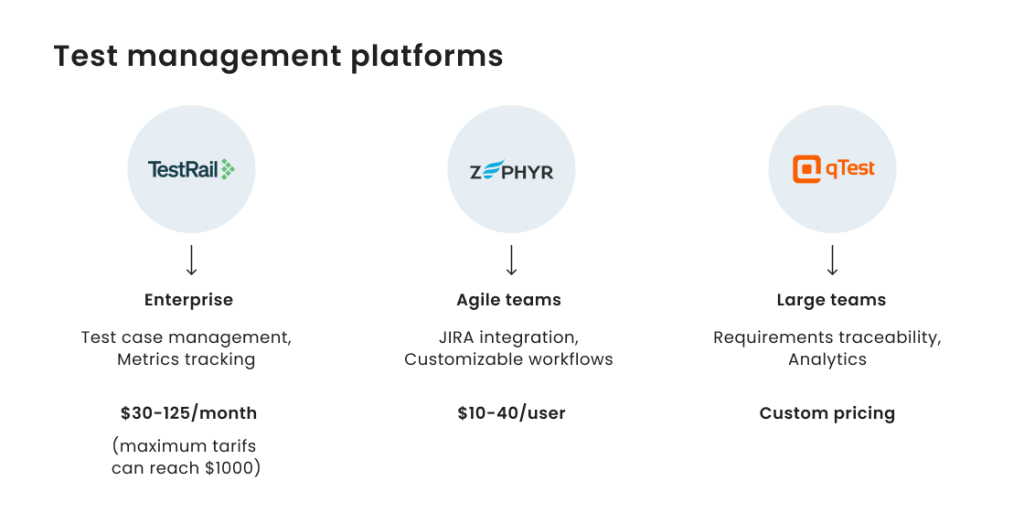
Automation Frameworks
For Native Apps
| Appium | XCUITest (iOS) | Espresso (Android) |
| – Cross-platform testing – Supports iOS and Android – Language flexibility – Active community – Free and open source | – Native Apple framework – Swift/Objective-C support – Direct iOS integration – Reliable performance – Built into Xcode | – Google’s testing framework – Java/Kotlin support – Fast execution – Stable tests – Android Studio integration |
For cross-Platform Apps
| Detox | Flutter Driver |
| – React Native focused – Gray box testing – Fast execution – Clear debugging – Active maintenance | – Flutter apps testing – Widget testing – Integration testing – Performance profilingBuilt-in support |
Cloud Testing Platforms
Device farms
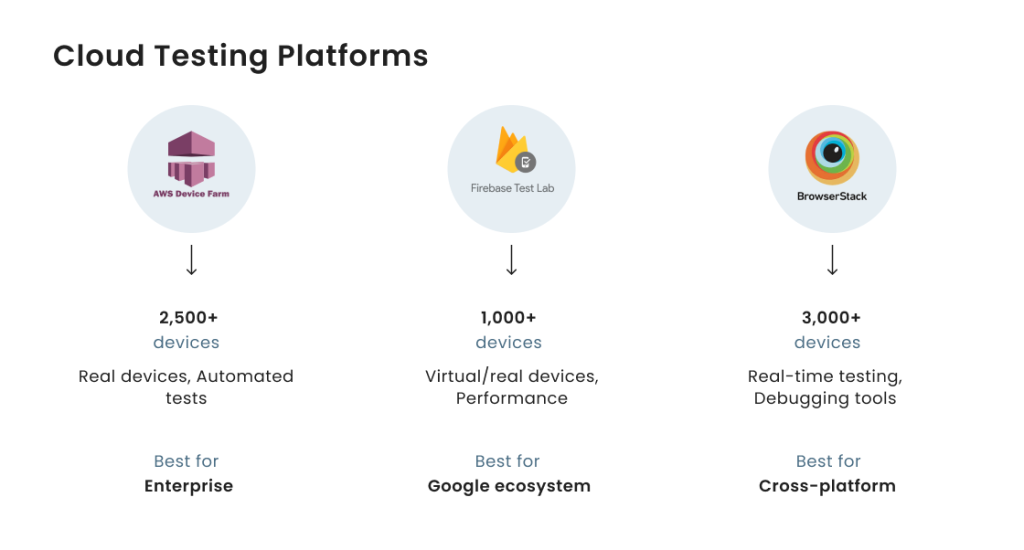
Performance testing tools
| New Relic Mobile | Firebase Performance Monitoring |
| – Real-time monitoring – Crash analytics – Network insights – User behavior tracking – Custom metrics | – Free tier available – Real-user monitoring – Automatic issue detection – Integration with Google Analytics – Custom traces |
Track these KPIs (performance testing metrics):
- Launch time (cold/warm);
- Frame rate;
- Memory usage;
- Battery impact;
- Network efficiency.
Automated testing hierarchy
(теж картинку будь ласка)
Layer 1: Unit Tests (70%)
– Component testing
– API validation
– Business logic
Layer 2: Integration Tests (20%)
– Feature flows
– Cross-component interaction
– Data flow validation
Layer 3: UI Tests (10%)
– Critical user paths
– Visual regression
– Platform-specific features
For more information about layers in testing, check our focused newsletter issue.
Testing techniques by app type
Native apps
| Priority testing areas | Recommended tools |
| 1. Platform-specific features 2. Hardware integration 3. Performance optimization 4. Security compliance 5. Store guidelines | XC UITest for iOS Espresso for Android Charles Proxy for network testingInstruments for profiling |
Hybrid apps
| Priority testing areas | Recommended tools |
| 1. Cross-platform consistency 2. WebView performance 3. Native bridge functionality 4. Platform adaptability5. Network handling | Appium Selenium for WebView Chrome DevTools Safari Web Inspector |
Security testing tools
| Tool Type | Examples | Use Cases |
| Static analysis | SonarQube, Fortify | Code security |
| Dynamic analysis | OWASP ZAP, Burp Suite | Runtime security |
| Network analysis | Charles Proxy, Wireshark | API security |
Is your app security-ready for 2025?
Mobile QA Strategy and Test Plan
Here’s what an effective mobile testing process looks like in 2025 – stage by stage, with tools and techniques that actually work. Each phase builds on the previous one, creating a testing workflow that catches issues early and ensures quality throughout development.
#1. Planning stage: Define scope and coverage
At this stage, you identify the types of testing needed and ensure proper coverage across devices to test various functionalities. The goal is to establish a strong foundation for mobile app testing.
Techniques
- Risk-based testing. Prioritize critical areas such as payment systems and security protocols.
- Test planning with mind maps. Tools like XMind help visualize key areas to test the app comprehensively.
- Device matrix creation. Use analytics from tools like Firebase to identify the most prevalent devices for mobile testing.
Recommended tools
- Zephyr. For managing test cases.
- TestRail. To track the progress of testing efforts.
The growth of mobile devices means there are numerous combinations of OS versions, screen sizes, and hardware configurations. This stage ensures that your testing of mobile apps targets the right mobile devices for maximum impact.
#2. Development stage: Integrating testing early
Integrating testing during development helps catch defects before they escalate, saving time and resources.
Techniques
- Shift-left testing. Perform mobile app testing alongside development to address issues early.
- Test-driven development (TDD). Write tests before coding to guide development.
- Static code analysis. Evaluate code for vulnerabilities and performance bottlenecks.
Recommended tools
- SonarQube. For identifying code issues.
- Postman. To test APIs used by the app.
Testing is also crucial here because it ensures that early versions of the app meet foundational quality standards. With mobile apps being tested at this stage, potential risks can be mitigated effectively.
#3. Pre-release stage: Ensuring functionality and stability
This stage focuses on validating that the app performs well on different mobile devices and under various conditions.
Techniques
- Automated mobile regression testing. Run automated tests to check for issues introduced during development.
- Compatibility testing. Ensure the app functions consistently across different mobile operating systems, screen sizes, and hardware configurations.
- Exploratory Testing: Testers perform ad-hoc testing to uncover unexpected issues.
Recommended tools
- Appium. For automated mobile app testing.
- BrowserStack. To perform mobile testing across devices.
- Kobiton. For testing different mobile environments.
With mobile apps being tested on various devices, this stage ensures that the app is robust enough to handle the diversity of devices for mobile usage today. Testing is very important to guarantee that your mobile app testing involves all critical aspects, such as functionality, performance, and compatibility.
#4. Post-release stage: Monitoring and optimization
After the app is released, ongoing testing ensures a seamless mobile experience for users and allows quick fixes for any issues.
Techniques
- Crash Monitoring: Collect real-time crash reports to prioritize urgent fixes.
- Real User Monitoring (RUM): Track how users interact with the app in real-world scenarios.
- A/B Testing: Optimize features based on user feedback to improve the app experience.
Recommended tools
- Firebase crashlytics. For monitoring app crashes.
- New relic mobile. To track app performance.
- Mixpanel. For user behavior analytics.
App stores like Google Play and the Apple App Store have stringent requirements, and continuous monitoring ensures your app maintains compliance and high ratings. Post-release testing helps identify and resolve issues that can impact user retention.
#5. Advanced techniques: AI and Machine Learning in testing
AI-driven tools are revolutionizing mobile app testing, offering smarter solutions for complex scenarios.
Techniques
- Self-healing test automation. AI adapts tests automatically to UI changes.
- Anomaly detection. Identify irregular patterns in app behavior to predict issues.
- Visual AI testing. Validate visual consistency across different mobile devices.
Recommended tools
- Testim. For AI-driven test automation.
- Applitools Eyes. For pixel-perfect visual testing.
- Mabl. For AI-based functional testing.
AI automation makes testing smarter by reducing human intervention and increasing coverage. It ensures your app meets modern performance benchmarks while adapting to the dynamic demands of the market.
#6. Key metrics to track for continuous improvement
Testing of mobile apps requires delivering measurable quality. Focus on these metrics to assess testing effectiveness:
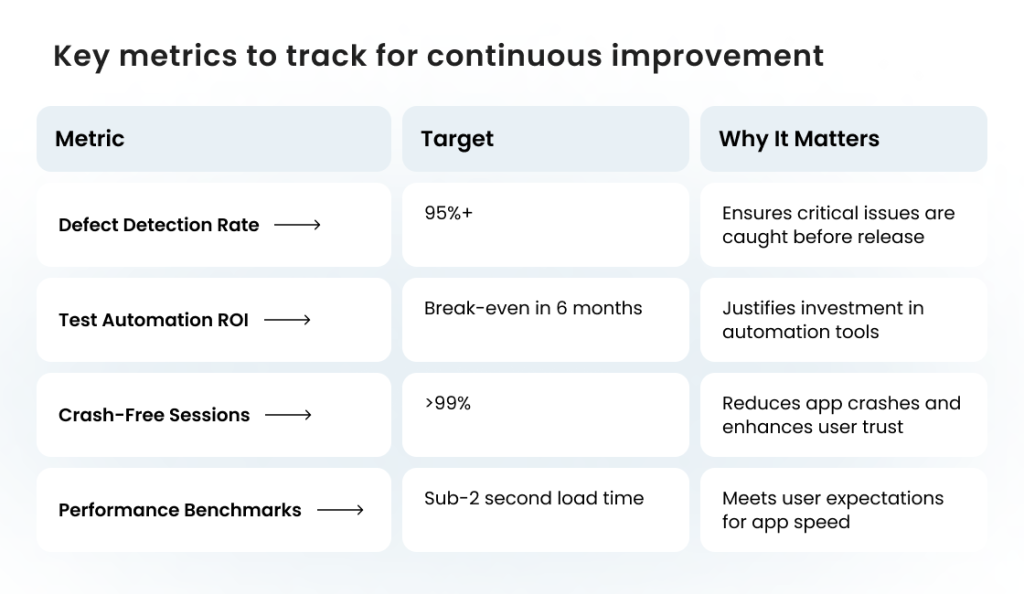
Enterprise-Scale Mobile Testing
Explore how we helped a European bank prepare for global expansion:
– Hardware-software integration
– Multi-device testing
– UI/UX optimization
Mobile Testing Challenges and How to Overcome Them
Mobile app quality assurance isn’t optional. With users expecting seamless experiences across various mobile devices, from Android to iOS, testing applications has become more complex than ever. Whether you’re ensuring your app’s performance on real mobile devices or simulating conditions in a testing environment, the need to test thoroughly is clear.
Fragmentation
Testing across the countless Android and iOS devices, each with unique screen sizes, OS versions, and hardware, creates a significant challenge. A single app must function reliably on many mobile devices, making comprehensive coverage essential.
- Prioritize testing. Focus on the most popular devices and OS versions for your audience.
- Use tools. Use emulators and simulators for efficient initial testing.
- Test on real mobile devices. Validate critical features on physical devices to ensure your mobile app performs well in real-world scenarios.
- Cloud-based device farms. Expand coverage by accessing a broader range of mobile devices through the cloud.
- Outsource. Partner with external QA teams for additional device diversity and expertise.
Emulators vs. Simulators
These tools streamline the testing process but have specific use cases:
- Emulators. Mimic the hardware and OS of Android and iOS devices. Ideal for assessing hardware interactions and app performance.
- Simulators. Focus on software behavior, enabling tests of UI responsiveness and app flow without relying on hardware.
While useful, emulators and simulators don’t replace real testing. Validate your app’s performance on physical devices to ensure reliability under real-world conditions.
OS release cycles
Frequent updates to Android and iOS introduce new features, designs, and APIs. Apps must adapt quickly to maintain compatibility and performance across legacy and latest versions.
- Include new OS versions in your testing plan early.
- Monitor how updates affect the app’s functionality and optimize for backward compatibility.
Customization
Android devices often feature custom user interfaces (e.g., Samsung One UI, Xiaomi MIUI) that affect app performance and usability. Testing must go beyond standard Android and iOS devices to account for these variations.
- Evaluate your app on popular custom UIs to ensure smooth performance and compatibility.
- Pay attention to performance on mid-tier and older devices to ensure a good experience for all users.
Deployment and update cycles
Submitting apps to stores like Google Play and the Apple App Store involves rigorous review processes. Apple is stricter but faster, while Google’s broader requirements can delay deployment.
- Test the app thoroughly before submission to minimize rejections or delays.
- Plan synchronized updates for iOS and Android devices by factoring in review timelines.
Regarding mobile testing, ensuring that your mobile app meets user expectations requires a systematic approach. Whether you’re testing different web applications or validating your app on various mobile devices, a mix of tools and real testing is essential. By addressing fragmentation, using emulators and simulators, and prioritizing real-world conditions, you can enhance your app’s performance and deliver experiences users trust.
Wrapping Up
Mobile testing is hard. No amount of tools or frameworks will change that. But you can make it manageable:
Start small. Focus on critical user flows first — things like logins, purchases, and core features. One solid automated test is better than ten flaky ones.
Pick your battles with device testing. You don’t need to test on every device. Look at your analytics, pick the top 20 device/OS combinations your users actually have, and focus there.
When bugs happen (and they will):
- Document the exact steps and device info
- Add it to your test suite so it doesn’t come back
- Track patterns — recurring issues often point to deeper problems
For automation:
- Keep your test data separate from your test code
- Write tests that tell you exactly what broke and where
- Run your most important tests on every commit
Don’t chase perfect coverage. Chase useful coverage. Better to have reliable tests for your core features than to try to automate everything and maintain a mess of unreliable tests.
And remember — tools change, frameworks come and go, but good testing fundamentals stay the same. Build a solid foundation of test cases, clear bug reports, and reproducible test environments. The rest is just implementation details.
We do this type of work well, as we think, you can tell by now. So, if you have some practical questions, book a free call session, and we will talk.
Frequently Asked Questions
 Why is mobile app testing more critical than ever in 2025?
Why is mobile app testing more critical than ever in 2025?
With over 7.5 billion mobile users and rapid release cycles, even a single crash can cause 71% of users to uninstall your app. Testing ensures high performance, security, and compliance, which are essential to retain users and reduce costs.
 What is the best mix of testing methods for mobile apps?
What is the best mix of testing methods for mobile apps?
A balanced combination of manual testing, traditional automation, and AI-powered automation tailored to your app type and project size is recommended. Large projects benefit from AI and automation for regression and edge cases, while manual testing excels in usability and exploratory testing.
 How do emulators and simulators fit into mobile app testing?
How do emulators and simulators fit into mobile app testing?
Emulators mimic hardware and OS, ideal for hardware interaction and performance testing. Simulators focus on software behavior and UI responsiveness. Both are useful but cannot replace real device testing to ensure reliability under real-world conditions.
 What are the key challenges in mobile app testing?
What are the key challenges in mobile app testing?
Fragmentation of devices and OS versions, frequent OS updates, custom Android UIs, and store deployment requirements create complexity. Prioritizing devices, using cloud device farms, and integrating early testing help overcome these challenges.
 How can AI improve mobile app testing?
How can AI improve mobile app testing?
AI-powered tools provide self-healing automation, anomaly detection, and visual testing, reducing maintenance overhead and increasing test coverage, making testing smarter and more cost-efficient.
Jump to section
Hand over your project to the pros.
Let’s talk about how we can give your project the push it needs to succeed!
